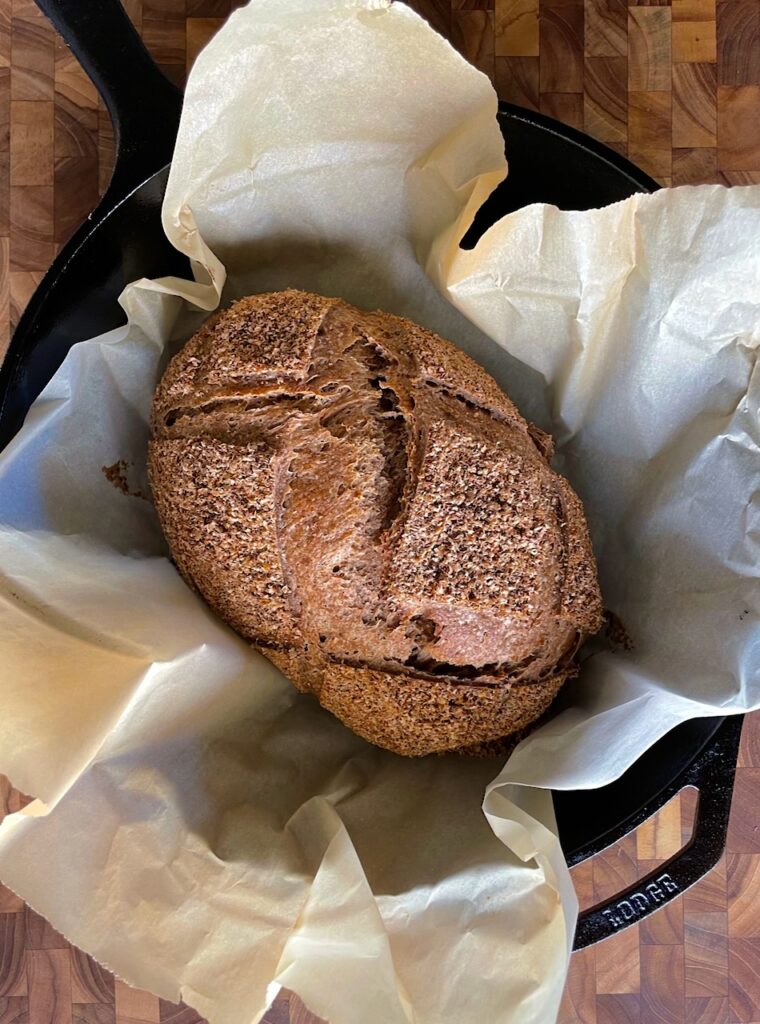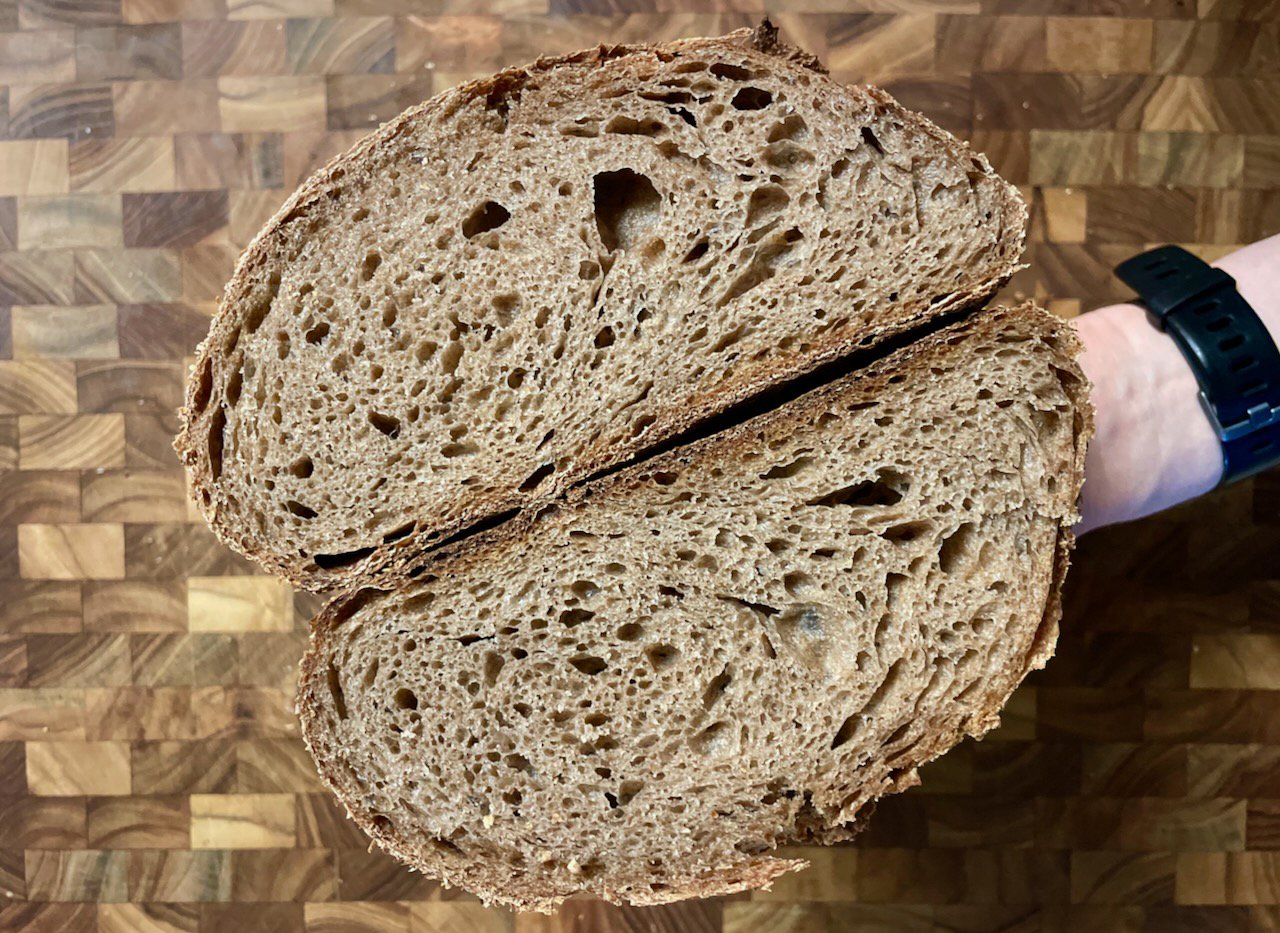Disclosure: this page may contain affiliate links, where I earn a commission (at no cost to you) if you decide to make a purchase. With that being said, I will only ever recommend products that I actually use and fully endorse.

A hearty and flavorful rustic loaf, made with 100% whole wheat flour, and sourdough leavened.
Making an exclusively whole wheat loaf the same way you make an all white loaf would be a mistake. Believe me, I’ve tried. Unfortunately, the wonderful fibers that make whole wheat tasty and nutritious can also make it dense and dry. This may be why homemade whole wheat bread has a bit of a bad reputation. But it doesn’t have to that way. With a few simple tweaks, this 100% whole wheat sourdough bread manages to be soft and airy, with a pleasant lacy crumb.
How is this possible, you ask? First off, an overnight autolyse is key to softening the fibers and strengthening the gluten formation. Adding a little bit of oil ensures a tender, moist interior. And it bakes in a cast-iron pot for a crisp, bakery-style crust. Sourdough leavening—in combination with the whole wheat flour—imparts a tart, nutty flavor. Use it for sandwiches, toasts, or just smeared with butter. And don’t be surprised if it becomes one of your new favorite loaves.
Equipment and Ingredients
This 100% whole wheat sourdough bread bakes in a heavy covered pot, so make sure you have one on hand. For a batard, or oblong loaf, a 12-inch deep skillet with lid will work. For a boule, or round loaf, a Dutch oven is ideal. If you are on the market for a Dutch oven, take a look at Nest Homeware. They are offer a 3.5 qt cast iron Dutch oven that is both beautiful and highly functional. If you don’t have a Dutch oven or deep skillet with lid, you can experiment with baking on a pizza stone, with a pan of boiling water in the oven.
This recipe also requires active sourdough starter. This means your starter should at least double 12 hours after being fed, and be used within 24 hours of feeding. Your starter may require more than one feeding prior to baking, so plan ahead.
Otherwise, it does not require any special equipment. Certain equipment may be helpful though. I highly recommend a kitchen scale for accurate measurements. Volumetric measurements are provided in this recipe, but be sure to sift and level appropriately for best results. For a batard, an oblong proofing basket is essential, but for a boule you can get away with a towel lined bowl. Other tools you may find helpful are a bench scraper and lame (a razor for scoring the bread). A quality serrated knife is also helpful when it comes time to cut the finished loaf. If you do not have one, the bread can be torn apart with your hands. This works best if you are serving it with soup or a saucy meal.
Timetable for 100% whole wheat sourdough bread
The long overnight autolyse for this loaf means the total journey from start to finish takes 2-3 days. This may seem like a lot but it’s mostly hand-off. And it makes for a great weekend project!
On day one your are simply mixing together the flour and water. I recommend doing this in the evening and allowing it to autolyse overnight. The next morning you can add the remaining ingredients and knead the dough. It will then begin the bulk fermentation, a process that can take 6 hours or more depending on the temperature and strength of your starter. Next you will shape it into a loaf and begin the final proofing. You can choose to proof at room temperature (for around 2-4 hours) and bake the same day, or cold proof in the fridge and bake the next day. Either way will be delicious, and the enchanting smell that fills your home will be a delightful culmination to this lengthy process.
More like this:
For more whole wheat wonders, check out my Honey Whole Wheat Sourdough Sandwich Bread, 50% Whole Wheat No-Knead Sourdough, and Sourdough Fougasse.
My entire collection of sourdough breads can be found here.

100% Whole Wheat Sourdough Bread
Ingredients
- 390 grams (2½ cups) whole wheat flour
- 320 grams (1⅓ cup) water
- 8 grams (1⅓ tsp) fine salt
- 25 grams (2 tbsp) extra virgin olive oil
- 100 grams (⅓ cup + 1 tbsp) sourdough starter active/fed
- Wheat bran, brown rice flour, or whole wheat flour for dusting
Instructions
- Combine flour and water in a large bowl. Mix together just until a shaggy dough forms and no dry bits remain. Cover with plastic wrap or a damp towel. Leave to rest overnight, 8-12 hours.
- Add salt and olive oil to the dough and work them in by hand until incorporated.
- Add sourdough starter to the dough and work in by hand or with a wooden spoon until incorporated.
- Knead dough by hand or with a mixer fitted with dough hook. Knead until dough is smooth and supple. Allow dough to rest for 5 minutes. Take a small piece of dough and stretch it into a square with your hands. If you are able to stretch the dough thin enough that light shines through without the dough tearing then it has been adequately kneaded. If dough tears continue kneading, allow to rest, and then repeat this test. Continue until dough passes this “windowpane test”.
- Place dough in a clear bowl or container. Mark the position of the top of the dough with a rubber band, tape, or washable marker. Allow dough to rise until increased in volume by about 50%. This may take around 6 hours but this depends on the ambient temperature and the strength of your starter (see note).
- Fill a small bowl with water. Use your hands to wet a work surface with water and transfer dough to work surface. Stretch dough into a rough square. Fold the corners into the middle. Cover and let rest for 15 minutes.
- To make a batard: Dust a lined oblong proofing basket with wheat bran, brown rice flour, or whole wheat flour. Uncover dough and wet hands. Fold the dough in thirds like a letter and then roll up like a sleeping bag from one of the short ends into a tight cylinder. If dough is still slack, roll up again from the short end to create a taut cylinder. Pinch seems together. Place dough seem side up in proofing basket and dust the exposed side of the dough with flour or wheat bran.
- To make a boule: Dust a lined round proofing basket with flour or wheat bran. Alternatively, line an 8 to 9-inch bowl or colander with a towel and dust with flour or wheat bran. Uncover the dough. Wet hands and again fold each corner into the middle. Repeat again, folding the corners into the middle. The dough at this point should be a somewhat taut ball, if not fold the corners in again until it is. Pinch seems together. Place dough seem side up in proofing basket and dust the exposed side of the dough with flour or wheat bran.
- Cover dough with a towel and transfer to the fridge. Allow dough to cold proof in the fridge for 12-24 hours. Alternatively, proof at room temperature for 2-4 hours until dough has about doubled in volume.
- When ready to bake preheat oven to 400°. Carefully flip your dough out of the proofing basket and onto a sheet of parchment paper seem side down. Score the top of the loaf about ¼-inch deep with a serrated knife or razor blade. The scoring can be a single slash down the middle, a cross, a square, or any pattern you like.
- If baking a batard, place dough in a deep skillet with lid, if baking a boule place dough in a Dutch oven. Add an ice cube to the pot and cover. Bake for 30 minutes then remove lid and bake for an additional 20-30 minutes or until browned and loaf sounds hollow when tapped on the bottom. Remove to a wire rack to cool completely (at least an hour) before cutting into your bread.


This is my first time making bread. Can I bake in a loaf pan if I place the loaf pan down inside my Dutch oven? Thanks!
As long as the loaf pan fits in the Dutch oven I think it should be fine 👍
First time making your bread its the best wheat bread i made till today ,i just need to figure out why mine didn’t grew much in oven overall its pretty
Actually my dutch oven is pretty big maybe that or the heat wasent enough for my bread but your tricks made a good loaf of wheat bread .thank you